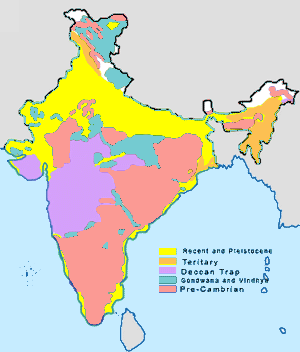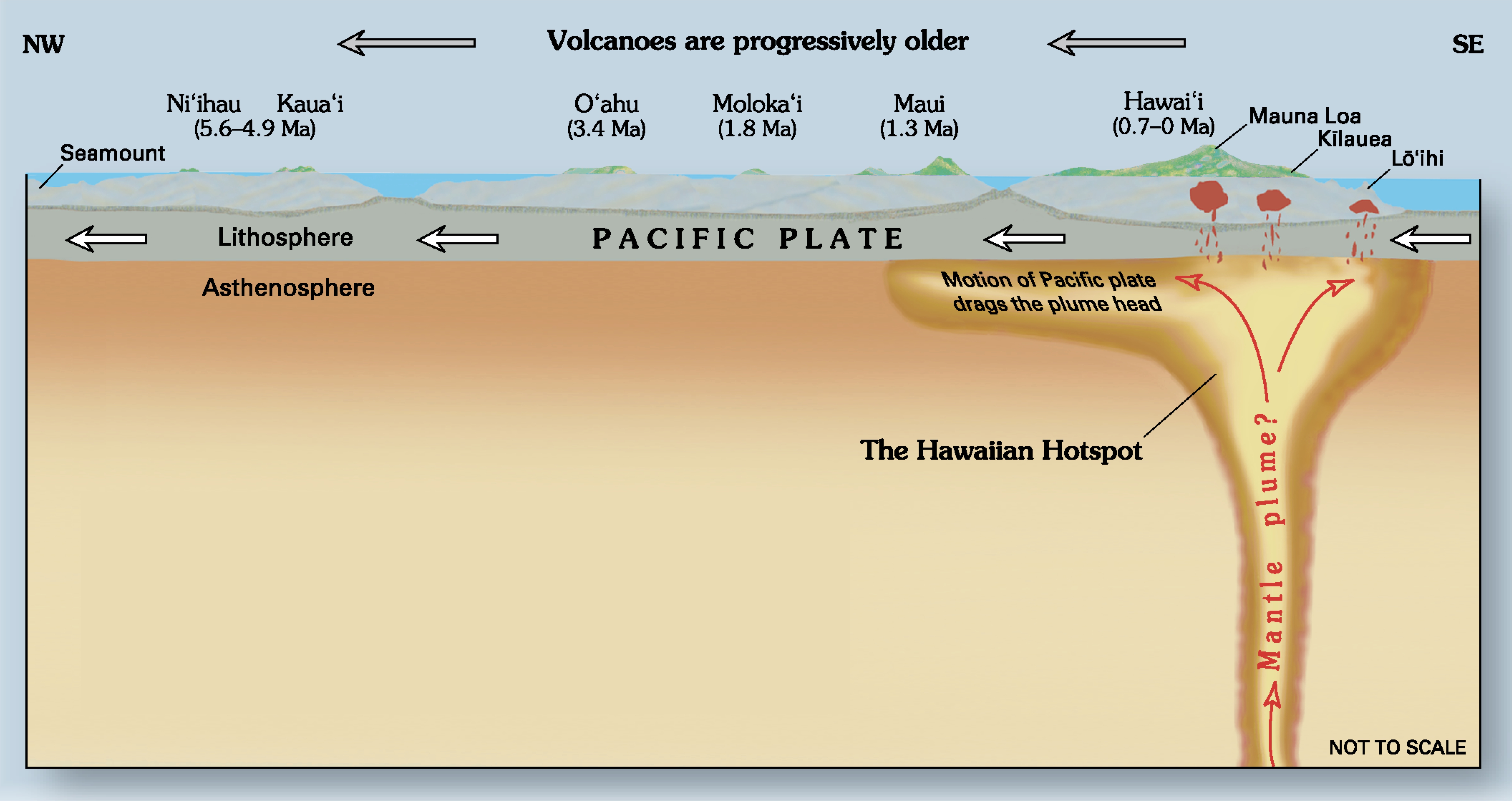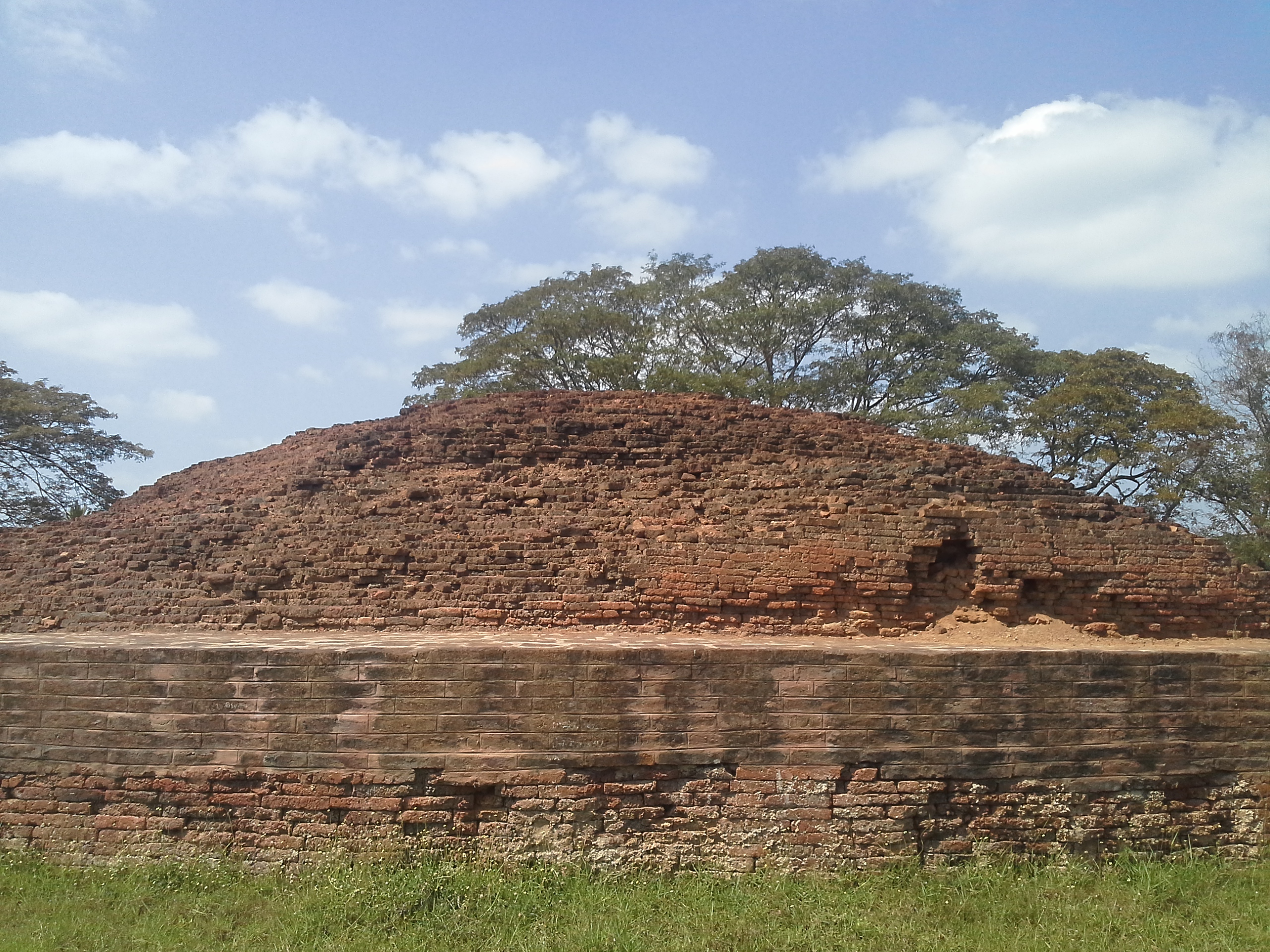|
Geology Of India
The geology of India is diverse. Different regions of the Indian subcontinent contain rocks belonging to different geologic periods, dating as far back as the Eoarchean Era. Some of the rocks are very deformed and altered. Other deposits include recently deposited alluvium that has yet to undergo diagenesis. Mineral deposits of great variety are found in the subcontinent in huge quantities. Even India's fossil record is impressive in which stromatolites, invertebrates, vertebrates and plant fossils are included. India's geographical land area can be classified into the Deccan Traps, Gondwana and Vindhyan. The Deccan Traps covers almost all of Maharashtra, a part of Gujarat, Karnataka, Madhya Pradesh and Andhra Pradesh marginally. During its journey northward after breaking off from the rest of Gondwana, the Indian Plate passed over a geologic hotspot, the Réunion hotspot, which caused extensive melting underneath the Indian Craton. The melting broke through the surf ... [...More Info...] [...Related Items...] OR: [Wikipedia] [Google] [Baidu] |
Vindhyan
The Vindhya Range (also known as Vindhyachal) () is a complex, discontinuous chain of mountain ridges, hill ranges, highlands and plateau escarpments in west-central India. Technically, the Vindhyas do not form a single mountain range in the geological sense. The exact extent of the Vindhyas is loosely defined, and historically, the term covered a number of distinct hill systems in central India, including the one that is now known as the Satpura Range. Today, the term principally refers to the escarpment and its hilly extensions that runs north of and roughly parallel to the Narmada River in Madhya Pradesh. Depending on the definition, the range extends up to Gujarat in the west, Uttar Pradesh and Bihar in the north, and Chhattisgarh in the east. The average elevation of the Vindhyas is also dependent on different sources. The word Vindhya is derived from the Sanskrit word ''vaindh'' (to obstruct) and is in reference to a mythological story. The Vindhya range is also known as ... [...More Info...] [...Related Items...] OR: [Wikipedia] [Google] [Baidu] |
Jharkhand
Jharkhand (; ) is a States and union territories of India, state in East India, eastern India. The state shares its border with the states of West Bengal to the east, Chhattisgarh to the west, Uttar Pradesh to the northwest, Bihar to the north and Odisha to the south. It is the List of states and territories of India by area, 15th largest state by area, and the List of states and union territories of India by population, 14th largest by population. Hindi is the official language of the state. The city of Ranchi is its capital and Dumka its sub-capital. The state is known for its waterfalls, hills and holy places; Baidyanath Temple, Baidyanath Dham, Parasnath, Maa Dewri Temple, Dewri and Rajrappa are major religious sites. Jharkhand is primarily rural, with about 24% of its population living in cities as of 2011. Jharkhand suffers from what is sometimes termed a resource curse: it accounts for more than 40% of Mining in India, India's mineral production but 39.1% of its populati ... [...More Info...] [...Related Items...] OR: [Wikipedia] [Google] [Baidu] |
Bihar
Bihar ( ) is a states and union territories of India, state in Eastern India. It is the list of states and union territories of India by population, second largest state by population, the List of states and union territories of India by area, 12th largest by area, and the List of Indian states and union territories by GDP, 14th largest by GDP in 2024. Bihar borders Uttar Pradesh to its west, Nepal to the north, the northern part of West Bengal to the east, and Jharkhand to the south. Bihar is split by the river Ganges, which flows from west to east. On 15 November 2000, a large chunk of southern Bihar was ceded to form the new state of Jharkhand. Around 11.27% of Bihar's population live in urban areas as per a 2020 report. Additionally, almost 58% of Bihari people, Biharis are below the age of 25, giving Bihar the highest proportion of young people of any Indian state. The official language is Hindi, which shares official status alongside that of Urdu. The main native languag ... [...More Info...] [...Related Items...] OR: [Wikipedia] [Google] [Baidu] |
Odisha
Odisha (), formerly Orissa (List of renamed places in India, the official name until 2011), is a States and union territories of India, state located in East India, Eastern India. It is the List of states and union territories of India by area, eighth-largest state by area, and the List of states and union territories of India by population, eleventh-largest by population, with over 41 million inhabitants. The state also has the third-largest population of Scheduled Castes and Scheduled Tribes, Scheduled Tribes in India. It neighbours the states of Jharkhand and West Bengal to the north, Chhattisgarh to the west, and Andhra Pradesh to the south. Odisha has a coastline of along the Bay of Bengal in the ''Indian Ocean''. The region is also known as Utkaḷa and is mentioned by this name in India's national anthem, Jana Gana Mana. The language of Odisha is Odia language, Odia, which is one of the Classical languages of India. The ancient kingdom of Kalinga (historical region), ... [...More Info...] [...Related Items...] OR: [Wikipedia] [Google] [Baidu] |
Chhattisgarh
Chhattisgarh (; ) is a landlocked States and union territories of India, state in Central India. It is the List of states and union territories of India by area, ninth largest state by area, and with a population of roughly 30 million, the List of states and union territories of India by population, seventeenth most populous. It borders seven states – Uttar Pradesh to the north, Madhya Pradesh to the northwest, Maharashtra to the southwest, Jharkhand to the northeast, Odisha to the east, Andhra Pradesh and Telangana to the south. Formerly a part of Madhya Pradesh, it was granted statehood on Chhattisgarh Rajyotsava, 1 November 2000 with Raipur as the designated state capital. The Jogimara and Sitabenga Caves, Sitabenga caves in Chhattisgarh, one of the earliest examples of theatre architecture in India, are dated to the Maurya Empire, Mauryan period of 3rd century BCE. The region was split between rivaling dynasties from the sixth to twelfth centuries, and parts of it were bri ... [...More Info...] [...Related Items...] OR: [Wikipedia] [Google] [Baidu] |
Flood Basalt
A flood basalt (or plateau basalt) is the result of a giant volcanic eruption or series of eruptions that covers large stretches of land or the ocean floor with basalt lava. Many flood basalts have been attributed to the onset of a hotspot (geology), hotspot reaching the surface of the Earth via a mantle plume. List of flood basalt provinces, Flood basalt provinces such as the Deccan Traps of India are often called ''Trap rock, traps'', after the Swedish word ''trappa'' (meaning "staircase"), due to the characteristic stairstep geomorphology of many associated landscapes. Michael R. Rampino and Richard Stothers (1988) cited eleven distinct flood basalt episodes occurring in the past 250 million years, creating large igneous provinces, lava plateaus, and mountain ranges. However, more have been recognized such as the large Ontong Java Plateau, and the Chilcotin Group, though the latter may be linked to the Columbia River Basalt Group. Large igneous provinces have been connected to ... [...More Info...] [...Related Items...] OR: [Wikipedia] [Google] [Baidu] |
Réunion Hotspot
The Réunion hotspot is a volcanic hotspot which currently lies under the island of Réunion in the Indian Ocean. The Chagos-Laccadive Ridge and the southern part of the Mascarene Plateau are volcanic traces of the Réunion hotspot. The hotspot is believed to have been active for over 65 million years. A huge eruption of this hotspot 65 million years ago is thought to have laid down the Deccan Traps, a vast bed of basalt lava that covers part of central India, and opened a rift which separated India from the Seychelles Plateau. The Deccan Traps eruption coincided roughly with the nearly antipodal Chicxulub impactor and the Cretaceous–Paleogene extinction of the dinosaurs, and there is considerable speculation that the three events were related. As the Indian plate drifted north, the hotspot continued to punch through the plate, creating a string of volcanic islands and undersea plateaux. The Laccadive Islands, the Maldives, and the Chagos Archipelago are atolls resting o ... [...More Info...] [...Related Items...] OR: [Wikipedia] [Google] [Baidu] |
Hotspot (geology)
In geology, hotspots (or hot spots) are volcanic locales thought to be fed by underlying Mantle (geology), mantle that is anomalously hot compared with the surrounding mantle. Examples include the Hawaii hotspot, Hawaii, Iceland hotspot, Iceland, and Yellowstone hotspots. A hotspot's position on the Earth's surface is independent of plate boundary, tectonic plate boundaries, and so hotspots may create a chain of volcanoes as the plates move above them. There are two hypotheses that attempt to explain their origins. One suggests that hotspots are due to mantle plumes that rise as thermal diapirs from the core–mantle boundary. The alternative plate theory (volcanism), plate theory is that the mantle source beneath a hotspot is not anomalously hot, rather the crust above is unusually weak or thin, so that lithospheric extension permits the passive rising of melt from shallow depths. Origin The origins of the concept of hotspots lie in the work of J. Tuzo Wilson, who postulated ... [...More Info...] [...Related Items...] OR: [Wikipedia] [Google] [Baidu] |
Indian Plate
The Indian plate (or India plate) is or was a minor tectonic plate straddling the equator in the Eastern Hemisphere. Originally a part of the ancient continent of Gondwana, the Indian plate broke away from the other fragments of Gondwana and began moving north, carrying Insular India with it. It was once fused with the adjacent Australian plate to form a single Indo-Australian plate, but recent studies suggest that India and Australia may have been separate plates for at least 3 million years. The Indian plate includes most of modern South Asia (the Indian subcontinent) and a portion of the basin under the Indian Ocean, including parts of South China, western Indonesia, and extending up to but not including Ladakh, Kohistan, and Balochistan in Pakistan. Plate movements Until roughly , the Indian plate formed part of the supercontinent, Gondwana, together with modern Africa, Australia, Antarctica, and South America. Gondwana fragmented as these continents drifted apa ... [...More Info...] [...Related Items...] OR: [Wikipedia] [Google] [Baidu] |
Andhra Pradesh
Andhra Pradesh (ISO 15919, ISO: , , AP) is a States and union territories of India, state on the East Coast of India, east coast of southern India. It is the List of states and union territories of India by area, seventh-largest state and the List of states and union territories of India by population, tenth-most populous in the country. Telugu language, Telugu is the most widely spoken language in the state, as well as its official language. Amaravati is the state capital, while the largest city is Visakhapatnam. Andhra Pradesh shares borders with Odisha to the northeast, Chhattisgarh to the north, Karnataka to the southwest, Tamil Nadu to the south, Telangana to northwest and the Bay of Bengal to the east. It has the Coastline of Andhra Pradesh, third-longest coastline in India at about . Archaeological evidence indicates that Andhra Pradesh has been continuously inhabited for over 247,000 years, from early archaic Hominini, hominins to Neolithic settlements. The earliest r ... [...More Info...] [...Related Items...] OR: [Wikipedia] [Google] [Baidu] |
Madhya Pradesh
Madhya Pradesh (; ; ) is a state in central India. Its capital is Bhopal and the largest city is Indore, Indore. Other major cities includes Gwalior, Jabalpur, and Sagar, Madhya Pradesh, Sagar. Madhya Pradesh is the List of states and union territories of India by area, second largest Indian state by area and the List of states and union territories of India by population, fifth largest state by population with over 72 million residents. It borders the states of Rajasthan to the northwest, Uttar Pradesh to the northeast, Chhattisgarh to the east, Maharashtra to the south, Gujarat to the west. The area covered by the present-day Madhya Pradesh includes the area of the ancient Avanti (India), Avanti Mahajanapada, whose capital Ujjain (also known as Avantika) arose as a major city during the second wave of Indian urbanisation in the sixth century BCE. Subsequently, the region was ruled by the major dynasties of India. The Maratha Confederacy, Maratha Empire dominated the maj ... [...More Info...] [...Related Items...] OR: [Wikipedia] [Google] [Baidu] |






